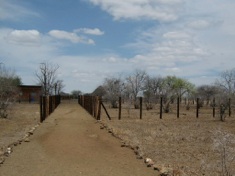Zimbabwe: Southeastern lowveld

Vulnerability and resilience of competing land-based livelihoods
Southeastern Zimbabwe is a drought prone region more suitable for both livestock and wildlife than for cropping. Local communities depend on livestock as their main source of livelihood, yet economists believe tourism with wildlife makes a lot more sense. This situation presents a conflict of interest between several stakeholders on best land-use options and natural resource conservation strategies. Already there are complex relationships between various sub-systems in the area: communal grazing / park grazing / smallholder grazing; water for cattle / for people / for wildlife; sorghum cropping / maize cropping; migration / cattle rustling / hunting or poaching, etc. Our work analyzes these linked systems and multi-scale patterns of resource use around which humans have organized themselves.
The research follows Walker & Salt (2006), who indicated that what is usually overlooked in the sustainability paradigm is that the key to sustainability lies in enhancing the resilience of communities, not in optimizing isolated parts of the system. Local communities are better able to withstand various cycles of change if they know more about the ecological drivers of their region, embrace rather than control the processes of natural change, and are empowered to make their own decisions about appropriate local developments; ‘Long term prosperity needs ‘resilience’ not just efficiency’ (Ludwig et al. 1997). Understanding complex human–environment systems thus involves understanding how cooperation and networks of interaction emerge from individual behaviour and feed back to influence such behaviour (Levin 2003, Easterling & Polsky 2003).
PhD researcher: Chrispen Murungweni (MSc)

Redressing asymmetry in resource allocation through co-operation among livestock & wildlife systems
One important cause of failure in natural resource management is mismatch of scales (Folke et al. 1998). These occur when the scales of ecological dynamics and the scale of social organization are aligned in a way that negatively affects an ecosystem (Cumming et al. 2006). The consequences of scale mismatches for the environment may be severe: inappropriate management often results in a loss of natural landscape heterogeneity and further impacts on broad-scale ecological processes such as the movement of species through landscapes (Cumming et al. 2006). In general, degraded ecological systems become less able to provide the goods and services that humans rely on and this subsequently leads to degraded social systems which result in a net decrease in human well-being. Therefore, this project seeks to add to an understanding of the topic of scale mismatches by studying spatio-temporal dynamics of resources shared between wildlife and livestock. The hypothesis to be tested is: harmonization of the socio-economic organization and ecological scales at the appropriate level, would lead to optimal allocation of resources between wildlife and livestock. Implying increased production and higher economic welfare for the majority of the stakeholders in the long term. This is based on the subsidiarity principle (Berkes 2006), which stipulates that ‘decisions should be taken as closely as possible to the citizen’ and that action should be taken at the level where it is most effective (Karlsson 2007). PhD researcher: Xavier Poshiwa (MSc)

References
Berkes, F. 2006. ‘From community-based resource management to complex systems: The scale issue and marine commons’, Ecology & Society 11(1). [online] URL: http://www.ecologyandsociety.org/vol11/iss1/art45/
Cumming, G.S., D.H.M. Cumming & C.L. Redman. 2006. ‘Scale mismatches in social-ecological systems: Causes, consequences, and solutions’, Ecology & Society 11(1). [online] URL: http://www.ecologyandsociety.org/vol11/iss1/art14/
Folke C., L. Jr. Pritchard, F. Berkes, J. Colding & U. Svedin. 1998. The problem of fit between ecosystems and institutions. Bonn: International Human Dimensions Programme on Global Environmental Change (IHDP).
Karlsson, S.I. 2007. ‘Allocating responsibilities in multi-level governance for sustainable development’, International Journal of Social Economics 34: 103-126

Human effects on tropical savanna multi-species wildlife communities, southeast lowveld, Zimbabwe
The question of whether animal populations are bottom-up controlled and/or top-down controlled has motivated a thriving body of research over the last 50 years. Previous studies have shown that strengths of bottom-up and top-down controls can vary between different ecosystems at the global level, with possible abrupt shifts in bottom-up and top-down controls between years appearing in arid and semi-arid regions between years with strong inter-annual variation in rainfall. It is therefore, important that research on the bottom-up and top-down controls in socio-ecological systems zooms in from global via continental to national (or local) levels. Few studies have examined the effects of human-induced bottom-up and top-down controls on large wild herbivore population abundances in tropical savannas. Humans as super-predators can exert a top-down control on large wild herbivore abundances through bushmeat hunting. In addition, by setting-up fires and livestock grazing, humans exert a bottom-up control on large wild herbivore abundances through altering resource availability which influences secondary productivity. Increasing human densities and deepening poverty particularly, may result in humans exerting more pressure on large wild herbivore population sizes in areas with limited or weak human management (or control) systems. The main objective of this study is to investigate the effects of human-induced top-down and bottom-up controls on ecosystem functioning. We do this by focussing on large wild herbivore multi-species communities in different tropical savanna conservation areas that are characterized by similar abiotic conditions but different human control systems in the southeast lowveld of Zimbabwe.
PhD researcher: Edson Gandiwa (MSc)


References
Easterling, W.E. & C. Polsky. 2002. ‘Crossing the complex divide: Linking scales for understanding coupled human–environment systems’, in: R.B. McMaster & E. Sheppard (eds). Scale and geographic inquiry, Oxford: Blackwell.
Levin, S.A. 2003. ‘Complex adaptive systems: Exploring the known, the unknown and the unknowable’, Bulletin of the American Mathematical Society 40, pp. 3–19.
Ludwig, D., B. Walker & C.S. Holling. 1997. ‘Sustainability, stability, and resilience’, Conservation Ecology 1(1): art7.
Walker, B. & D. Salt. 2006. Resilience thinking: Sustaining ecosystems and people in a changing world. Washington DC: Island Press.
click on
this side bar to
return to >projects

